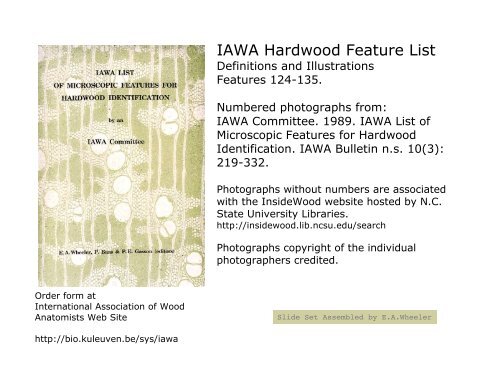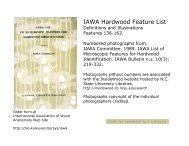IAWA Hardwood Feature List - Inside Wood
IAWA Hardwood Feature List - Inside Wood
IAWA Hardwood Feature List - Inside Wood
Create successful ePaper yourself
Turn your PDF publications into a flip-book with our unique Google optimized e-Paper software.
Order form at<br />
International Association of <strong>Wood</strong><br />
Anatomists Web Site<br />
http://bio.kuleuven.be/sys/iawa<br />
<strong>IAWA</strong> <strong>Hardwood</strong> <strong>Feature</strong> <strong>List</strong><br />
Definitions and Illustrations<br />
<strong>Feature</strong>s 124-135.<br />
Numbered photographs from:<br />
<strong>IAWA</strong> Committee. 1989. <strong>IAWA</strong> <strong>List</strong> of<br />
Microscopic <strong>Feature</strong>s for <strong>Hardwood</strong><br />
Identification. <strong>IAWA</strong> Bulletin n.s. 10(3):<br />
219-332.<br />
Photographs without numbers are associated<br />
with the <strong>Inside</strong><strong>Wood</strong> website hosted by N.C.<br />
State University Libraries.<br />
http://insidewood.lib.ncsu.edu/search<br />
Photographs copyright of the individual<br />
photographers credited.<br />
Slide Set Assembled by E.A.Wheeler
OIL AND MUCILAGE CELLS<br />
Oil cell = a parenchymatous idioblast filled<br />
with oil; mostly, but not always, enlarged and<br />
rounded in outline occasionally of<br />
considerable axial extension.<br />
Mucilage cell = a parenchymatous idioblast<br />
filled with mucilage; mostly, but not always,<br />
enlarged and rounded in outline occasionally<br />
of considerable axial extension.<br />
It is not practical to distinguish between<br />
oil and mucilage cells by their appearance.
<strong>Feature</strong> 124. Oil and/or mucilage cells<br />
associated with ray parenchyma<br />
Ocotea glaucinia (Lauraceae)<br />
P.E. Gasson<br />
Sassafras albidum (Lauraceae)<br />
E.A. Wheeler
<strong>Feature</strong> 125. Oil and/or mucilage cells<br />
associated with axial parenchyma<br />
Ocotea glaucinia (Lauraceae)<br />
P.E. Gasson.<br />
Cinnamomum camphorum (Lauraceae) FFPRI, Tsukuba,Japan.<br />
Oil cells in axial parenchyma (arrows), also in ray<br />
parenchyma.
<strong>Feature</strong> 126. Oil and/or mucilage cells<br />
present among fibres<br />
Ocotea tenella (Lauraceae) P.E. Gasson.
INTERCELLULAR CANALS<br />
Intercellular canal =<br />
a tubular<br />
intercellular duct<br />
surrounded by an<br />
epithelium, generally<br />
containing secondary<br />
plant products such as<br />
resins, gums, etc.,<br />
secreted by the<br />
epithelial cells.<br />
Synonyms: gum duct,<br />
resin duct.<br />
Parashorea smythiesii (Dipterocarpaceae)<br />
P.E. Gasson.
<strong>Feature</strong> 127. Axial canals in long tangential<br />
lines = more than five canals in a line.<br />
Shorea parviflora (Dipterocarpaceae)<br />
K. Ogata<br />
Shorea teysmanniana: L.Y.T. Westra<br />
Hand lens view<br />
Parashorea stellata: Els Bakker<br />
(Dipterocarpacae)
<strong>Feature</strong> 128. Axial canals<br />
in short tangential lines<br />
= two to five canals in a<br />
line.<br />
Dipterocarpus grandiflorus: D. Grosser<br />
(Dipterocarpacae)<br />
<strong>Feature</strong> 129. Axial canals<br />
diffuse = randomly<br />
distributed solitary<br />
canals.<br />
Dipterocarpus grandiflorus: K. Ogata<br />
(Dipterocarpacae)
<strong>Feature</strong> 130. Radial canals = canals present in rays.<br />
Synonym: horizontal canals.<br />
Bursera gumminfera: I.W. Bailey, Bailey-<br />
Wetmore Laboratory of Plant Anatomy and<br />
Morphology. (Burseraceae)<br />
Shorea hopeifolia: K. Ogata<br />
(Dipterocarpacae)
<strong>Feature</strong> 130. Radial canals = canals present in rays.<br />
Synonym: horizontal canals.<br />
Parashorea smythiesii<br />
(Dipterocarpaceae). K. Ogata<br />
Commiphora africana (Burseraceae)<br />
P.E. Gasson<br />
Tetragastris altissima(Burseraceaee)<br />
RMCA, Tervuren, Belgium
<strong>Feature</strong> 131. Intercellular canals of traumatic origin<br />
= canals formed in response to injury, arranged in<br />
tangential bands, generally irregular in outline and<br />
closely spaced.<br />
Murraya exotica P.E. Gasson (Rutaceae)<br />
Liquidambar styraciflua<br />
(Hamamelidaceae) E.A. Wheeler
Dyera costulata: P.E. Gasson<br />
(Apocynaceae)<br />
TUBES / TUBULES<br />
<strong>Feature</strong> 132. Laticifers or<br />
tanniniferous tubes.<br />
Structural differences between<br />
the two are minor. Therefore,<br />
they are combined into one<br />
descriptor.<br />
Laticifer = tubes<br />
containing latex,the latex<br />
may be colourless or light<br />
yellow to brown; laticifers<br />
may extend radially or<br />
axially (axial only known<br />
from Moraceae).<br />
Tanniniferous tubes = tubes<br />
containing tannins, which<br />
are reddish-brown, in rays<br />
(so far only known from<br />
Myristicaceae).
<strong>Feature</strong> 132. Laticifers<br />
or tanniniferous tubes.<br />
Alstonia scholaris K. Ogata (Apocynaceae)<br />
Dyera costulata. Wide laticifers. P.E. Gasson (Apocynaceae)<br />
Croton panamensis. P.E. Gasson (Euphorbiaceae)
<strong>Feature</strong> 132. Laticifers or<br />
tanniniferous tubes.<br />
Artocarpus communis,<br />
Axial laticifer<br />
<strong>IAWA</strong> Bull.1980.<br />
Topper & Koek-Noorman<br />
(Moraceae)<br />
Horsfieldia subglobosa.<br />
Tanniniferous tube. P.E. Gasson<br />
(Myristicaceae)
CAMBIAL VARIANTS<br />
<strong>Feature</strong> 133. Included phloem, concentric = phloem<br />
strands in tangential bands altrnating with zones of<br />
xylem and/or conjunctive tissue.<br />
Suaeda monoica (Chenopodiaceae) D. Grosser<br />
Avicennia sp. (Avicenniaceae) W. Bryan<br />
Handlens View
<strong>Feature</strong> 134. Included phloem, diffuse = scattered,<br />
isolated phloem strands. The phloem strands may be<br />
surrounded by parenchyma or imperforate elements.<br />
Cheiloclinium serratum (Celastraceae) M.E. Bakker<br />
Neea mollis (Nyctaginaceae) M.E. Bakker<br />
Strychnos nux-vomica (Loganiaceae) P.E. Gasson
<strong>Feature</strong> 135. Other<br />
cambial variants =<br />
category for a<br />
variety of cambial<br />
variants including<br />
axes elliptical,<br />
flattened and<br />
furrowed in cross<br />
section; axes with<br />
lobed or furrowed<br />
xylem; fissured<br />
xylem; compound,<br />
divided, corded and<br />
cleft xylem masses.<br />
Macfadyena unguis-cati. P.E. Gasson



